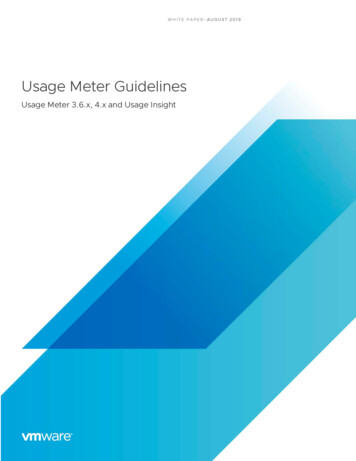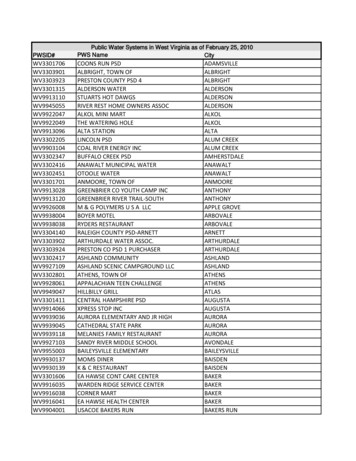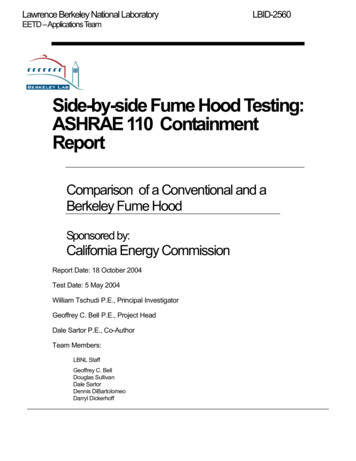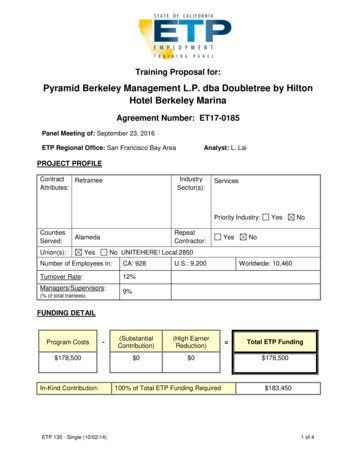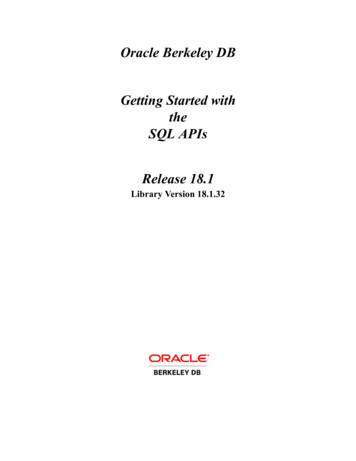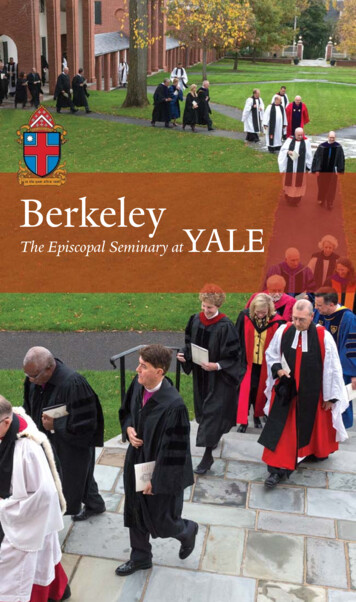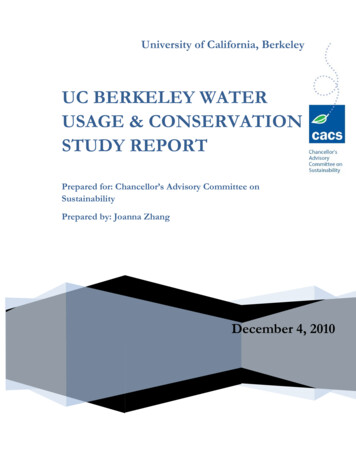
Transcription
University of California, BerkeleyUC BERKELEY WATERUSAGE & CONSERVATIONSTUDY REPORTPrepared for: Chancellor’s Advisory Committee onSustainabilityPrepared by: Joanna ZhangDecember 4, 2010
ContentsLIST OF TABLES & FIGURES . 3EXECUTIVE SUMMARY. 4BENCHMARKING. 4RESEARCH OF EXISTING STUDIES AND POLICIES. 5DATA COLLECTION . 6DATA ANALYSIS. 6RESULTS . 7Change in Consumptions between 1990 and 2009 . 7Total Consumption. 7Main Campus Accounts . 9Other Accounts . 10Residence Hall Accounts . 11Consumption Breakdown. 13Extrapolated Building Domestic- Campus Restroom Water Usage . 14FEASIBILITY STUDY . 14COST TABLE . 17REUSE AND RECYCLE OPTION . 17RECOMMENDATIONS . 19CACS Recommendations . 19Research Recommendation. 20SPEICAL THANKS . 21REFERENCE LIST . 21APPENDIX. 22CACS Water Associate Joanna ZhangPage 2
LIST OF TABLES & FIGURESTable 1: Consumption Change. 7Table 2: Project Feasibility . 15Table 3: CACS Recommendations . 20Table 4: Research Recommendations . 20Table 5: Annual Consumptions . 22Table 6: Main Campus Consumptions. 22Table 7: Other Accounts Consumptions . 23Table 8: Residence Hall Consumptions . 23Table 9: Population and Area . 24Table 10: 75% Toilet Fixture Replacement . 24Table 11: Campus Domestic Usage Calculation. 25Table 12: Campus Domestic Consumption . 25Figure 1: “A Sustainable Water Plan for University of California Berkeley” (Daniels, 2005) . 5Figure 2: Total Water Consumption (Gallons) . 7Figure 3: Total Consumption Gallons/Capita/Day . 8Figure 4: Total Consumption Gallons/Square Foot . 8Figure 5: Main Campus Consumption . 9Figure 6: Main Campus Gallon/Sq Ft . 9Figure 7: Main Campus Gallon/Capita/Day . 10Figure 8: Other Accounts Consumption . 10Figure 9: Residence Hall Total Consumption (Gallons). 11Figure 10: Residence Hall Consumption by Location . 11Figure 11: 2009 Residence Hall Consumption Breakdown. 12Figure 12: 2008 Estimated Campus Usage By Type . 13Figure 13: Estimated Campus Restroom Water Usage. 14Figure 14: Greywater Schematic for Toilet Use (Anglin, Maravilla, Miller, 2008) . 18Figure 15: Greywater Schematic for Irrigation (Anglin, Maravilla, Miller, 2008). 18CACS Water Associate Joanna ZhangPage 3
EXECUTIVE SUMMARYIn order to address California’s fourth consecutive year of drought, the State of California hasissued a state of emergency, passed water conservation legislation, and ordered immediate actionto mitigate a potential water shortage crisis. In response, the Chancellor’s Advisory Committeeon Sustainability (CACS) at University of California, Berkeley commissioned this report tobetter understand baseline water consumption and identify areas of opportunities for waterconservation with a focus on domestic 1 and industrial use of potable water in campus buildingsand Auxiliaries. Past reports on campus water consumption have not included all buildings andoperations. In addition, there are not sufficient meters and sub-meters to adequately assess usageand trend. A feasibility study of water conservation opportunities is conducted to identifypotential water saving projects.2009 California Delta-Water Bill Package Summary (http://gov.ca.gov/issue/water-supply): A new seven-member board to oversee the Sacramento-San Joaquin River Delta.A 20 percent conservation mandate for urban areas by 2020, with credits for citiesthat have made significant conservation efforts. Agricultural entities would have tofollow best practices for water use.New regulations to monitor groundwater levels throughout the state.Increased penalties for illegal water diversions, although the penalties and enforcementwere significantly weakened from an earlier plan.A 11.1 billion bond to pay for the overhaul.BENCHMARKINGBenchmarking research focused on other large universities’ water usage profiles. Waterconsumption at a range of universities was examined, including other research institutions anduniversities who have successfully reduced their consumption 2 . Total water usage by institutionsof higher education varies substantially by size, location and climate, efficiency of water usage,and other factors.It was not possible, however, to accurately analyze UC Berkeley’s usage against thesebenchmarks. Not all universities report water consumption and not all use the same protocol for1Domestic usage includes toilet, urinal, faucet and shower usages.Benchmarking information is obtained from http://www.greenreportcard.org/ for 2010 for Arizona StateUniversity, Georgia Institute of Technology, Pomona College, UC Davis, Duke University, UC San Diego, HarvardUniversity, and University of Washington. Follow-up phone calls were made to a smaller number of institutions.2CACS Water Associate Joanna ZhangPage 4
reporting usage 3 . In addition, there has been limited analysis of broad water usage patterns inhigher education.It was possible to examine best practices at other universities. The most common steps beingtaken by universities are one with a relatively low upfront cost: education and outreach,enhanced leak detection and repair, improved irrigation practices, and installation of low-flowdomestic fixtures (toilets, faucets, and showers). There are also examples of institutions whohave reduced water usage in laundries and cooling towers or who have found ways to expand theuse of non-potable water (e.g., through water reuse or rainwater capture).There were few schools, however, who had found it economical to convert all domestic featuresto low flow or to implement some of the more costly projects (e.g. conversion of all coolingtowers to a closed loop system). All such universities identified in this analysis were located inthe southeastern United States, which is experiencing a severe drought and possible near-termwater shortages. Otherwise, schools reported that relatively low water pricing meant that thefinancial feasibility of many projects was not sufficient for implementation.RESEARCH OF EXISTING STUDIES AND POLICIESThere are rich resources of past studies, projects, policies and educational programs regardingwater at U.C. Berkeley. One of the key documents evaluated is the “A Sustainable Water Planfor the University of California Berkeley” by Jubilee Daniels 2005.In the report, Daniels covered historic and current water use and disposal, campus sustainabilitypolicies, main campus water audit and result, the residence halls water audit and result, and casestudies of water conservation and reuse with new development and major renovations. Criticalsections including main campus water audit and residence hall water audit have provided muchassistance to the study. The conservation recommendations are illustrated in the graph below.Figure 1: “A Sustainable Water Plan for University of California Berkeley” (Daniels, 2005)3Key differences include how to report use of non-potable water sources and whether institutions were reportingusage by all campus buildings and operations.CACS Water Associate Joanna ZhangPage 5
DATA COLLECTIONIn collaboration with U.C. Berkeley Physical Plant-Campus Services, Cal Housing, and East BayMunicipal Utility District (EBMUD), historical potable water consumption data have beencollected and compiled. In the past campus Sustainability Assessments (2005, 2008, 2009),annual consumption was reported as the total of nine main campus meters covering areaapproximately bounded by Hearst Ave., Piedmont Ave., Bancroft Way and Oxford St. In thisstudy, however, in addition to the above, usage at residence halls and 98 additional wateraccounts 4 outside of the campus boundary is studied. While there are nine major water meterson campus and a number of smaller building meters present, complete historical consumptiondata have not been reported on an on-going basis. Furthermore, many individualfunctions/locations currently do not have working water meters, making it difficult to understandusage and trend.DATA ANALYSISThere are three main categories of data studied: main campus accounts, 98 additional accountsand Residence Hall accounts. The nine main campus accounts usage has been provided by Physical Plant-CampusServices (PP-CS).The usage of 98 ADDITIONAL accounts including nine F & H accounts, one FIRESERVICE account and 88 OTHER accounts has also been collected from PP-CS. Of thenine F & H accounts, two Lawrence Berkeley National Lab accounts were removed.Residence hall usage data is based on the historical records provided by EBMUD. Itincludes the list of accounts under “Housing and Dining” in the EnergyCAP Onlinesystem. Because these accounts do not provide the association with specific residenceunits, educated estimation is made based on investigation of the meter addresses in thesystem.With the complete sets of historical usage data from 1990 to 2009, a trendline analysis isperformed to study the usage pattern of the total consumption, main campus, other accounts andresidence halls. Overall, other than residence hall usages, all other usages have shownremarkable reduction since 1990.Additional analysis includes gallons/capita/day and gallons/square foot analysis. It is shown bythe usage that gallons/capita/day dropped from 64 gallons in 1990 to 49 gallons in 2009 andgallons/square foot dropped from 58 gallons in 1990 to 39 gallons in 2009.Furthermore, as it is important to understand the breakdown of the total water usage, acategorization has been developed to assist with further analysis. Because 2008 data are mostinclusive and accurate, total consumption for 2008 was used for the breakdown analysis. Majorcategories include “Steam Plant”, “Irrigation”, “Lab Building”, “Domestic—Residence Halls”,“Domestic—Other Buildings”, and “Other”. Among which, “Domestic—Other Buildings”includes all campus domestic usage which is calculated based on the types of the restroom4Two accounts for LBNL are excluded (6600791 and 6600801).CACS Water Associate Joanna ZhangPage 6
fixtures (3.5 gpf 5 , 1.6 gpf and etc) and the total campus population (staff, faculty, visitor andstudent).Domestic usage was estimated using an attendance-based analysis method. Assuming anaverage person (student, staff, faculty, or visitor) uses the restroom three times per day: a femaleuses the toilet three times, and a male uses the toilet once and the urinal twice. Based on theinventory of campus restroom fixtures, an average gallon per flush is calculated and extrapolatedto total annual consumption assuming 250 days per year and 51,000 daily campus populations.RESULTSChange in Consumptions between 1990 and 2009Year19902009% changeTotal Consumption739,296,692639,886,496-13%Main Campus504,155,740435,620,240-14%Other Accounts77,067,56630,697,172-60%Residence Halls158,073,386173,569,08410%Table 1: Consumption ChangeTotal ConsumptionFigure 2: Total Water Consumption (Gallons)5Gpf stands for gallon per flush.CACS Water Associate Joanna ZhangPage 7
Figure 3: Total Consumption Gallons/Capita/DayFigure 4: Total Consumption Gallons/Square FootAssumptions/Notes:1. Total consumption include usage from main campus accounts (9) and additional offcampus accounts (98), including industrial usages and Residence Hall usages.2. The additional accounts (1990-1997) usage data extrapolation is based on assumptionthat usage in these accounts changed by the same percentage as did the mainaccounts.CACS Water Associate Joanna ZhangPage 8
3. Total population includes FTE staff, FTE faculty, students, and assumed 2000 visitorsper day.4. Assumed Year 250 days.Main Campus AccountsFigure 5: Main Campus ConsumptionFigure 6: Main Campus Gallon/Sq FtCACS Water Associate Joanna ZhangPage 9
Figure 7: Main Campus Gallon/Capita/DayOther AccountsFigure 8: Other Accounts ConsumptionCACS Water Associate Joanna ZhangPage 10
Residence Hall AccountsFigure 9: Residence Hall Total Consumption (Gallons)Figure 10: Residence Hall Consumption by LocationCACS Water Associate Joanna ZhangPage 11
Figure 11: 2009 Residence Hall Consumption BreakdownAssumptions/Notes:1. 1990-2009 water consumption data are based on EBMUD records which include Unit1, 2, 3, 4, CKC and Other. (Other includes Channing & Bowditch Apt, Haste StreetChild Development Center, Manivlle Apt, RSSP Building, University Village andWestminster)CACS Water Associate Joanna ZhangPage 12
Consumption BreakdownFigure 12: 2008 Estimated Campus Usage By TypeAssumptions/Notes:1. The breakdown is analyzed from the total consumption in 2008 which includes maincampus accounts, other accounts and residence hall accounts.2. Assume Irrigation includes campus irrigation and residence halls irrigation.a. Assume current campus metered irrigation only accounts for 95% of campusirrigation.b. Assume residence halls irrigation accounts for 10% of total residence hallusage.3. Consumption from labs buildings including Latimer, Stanley, Koshland, LSA, VLSB,Birge, Etcheverry, McCone, Soda, Cory, and Hildebrand is obtained, of which 10% isassumed to be domestic usage and 90% is assumed to be lab usage.4. Assume 90% of Residence Hall usage is domestic.5. Assumed 90% of ADDITIONAL accounts is domestic.6. Assumes "Domestic-Other Buildings" includes campus restroom usages, 90% ofADDITIONAL account, and RSF showers.a. Assume 25% of RSF visitors shower after exercise.b. Assume gallon per min is 2 at RSF.c. Assume average length of shower is 8 min.7. Assumes "Other" category includes swimming pools, leaks, and other miscellaneoususage.CACS Water Associate Joanna ZhangPage 13
Extrapolated Building Domestic- Campus Restroom Water UsageFigure 13: Estimated Campus Restroom Water UsageAssumptions/Notes:1. GPF (Gallon Per Flush) is calculated to be a weighted average for low flow and nonlow flow fixtures based on Jubilee Daniel’s restroom fixture audits.2. Assume low flow 1.6 gpf toilet and 1.0 gpf urinal.3. Assume non-low flow 3.5gpf toilet and 1.6 gpf urinal.4. Assume gallon per min for faucets is 2.5. Assume average length of hand washing is 10 sec.6. Assume 74% of men and 83% of women wash hands after using the bathroom.(http://www.asm.org/Media/index.asp?bid 21773)7. Assume restroom user rate is Females 3 times a day, Males 1 a day for Toilets/ Twicea day for Urinals (Vickers, 2002).8. Assume Year 250 days.9. Assumed employee Male to Female ratio is 1:1.10. Total population includes FTE staff, FTE faculty, students, and assumed 2000 visitorsper day.FEASIBILITY STUDYA list of feasible projects is identified under three main categories: Possible Main CampusProject, Possible Auxiliary project, and Other Projects. The following table describes the MainCampus and Auxiliary Projects.CACS Water Associate Joanna ZhangPage 14
Proposed ProjectDescriptionAnnual WaterSavings(gallons)AnnualWaterSavings (%)UpfrontCapital Cost( )One TimeRebateNet AnnualCosts(Savings) ( )SimplePayback(years)Total NetPresent Value( )Possible Main Campus ProjectsGeneral Education &Awareness CampaignInstall Water Meters inLarge BuildingsEnhanced Leak ReductionEffortsExpand Sink AeratorInstallationsCampus Toilet ConversionAssumes broad base campuscampaign to raise awarenessand reduce water usage withunknown impact. 20,000Install 40 meters assuming 5000 cost per meter whichincludes PPCS labor costs 200,000Assumes all leaking toilets arerepaired (per CalCAP courseanalysis)Assumes 700 additionalbathroom sink aerators arechanged to 0.5 gpm from 2gpmAssumes 75% of toilets areretrofitted to low-flowAssumes 75% of urinals areretrofitted to low-flowReplace two leaking heatexchangersReplace 10 leaking heatexchangersCampus Urinal ConversionReplace Heat Exchangers(2)Replace Heat Exchangers(10)Subtotal w/ 2 HeatExchangers ReplacedSubtotal w/ 10* HeatExchangers ReplacedPossible Auxiliary ProjectsBehavior & FixtureImprovement in AuxiliariesAssumes reduction in waterconsumption at ResidenceHalls and RSF throughreducing shower length- 10,0004,265,3720.6% 10,000 18,9890.53 127,9176,548,0251.0% 3,841 29,1510.13 126,63625,940,0003.9% 527,742 37,913 115,4824.24 2,079,4145,640,0000.8% 265,698 76,350 25,1097.54 534,9632,102,4000.3% 100,000 9,36010.68 228,83410,512,0001.6% 500,000 46,79810.68 1,144,16844,495,7976.7% 1,127,281 188,0905.99 3,097,76352,905,3978.0% 1,527,281 225,5286.77 4,013,09716,000,0002.4%TBD 71,229.95Table 2: Project FeasibilityCACS Water Associate Joanna ZhangPage 15TBDTBD
Assumptions:1. Capital costs -- including hardware and labor -- are all incurred in first year.2. Discount rate 6%3. Estimated annual water savings from enhanced leak reduction efforts from CalCAPcourse analysis (2007).4. Assumes cost of water is 3.33 per ccf.5. Assumes General Education and Awareness Campaign’s costs include 20,000 upfrontcost and 10,000 annual cost.6. Assumes the water saving for replacing 312 aerators is 2,918,548.33 gallon per year.With additional 700 aerators replaced based on inventory check, the total estimated watersaving is 2,918,548.33/312*700 (Sink Aerator Replace Program Fall 2009)7. Assumes the cost for upgrading 312 aerators is 1440 272.12 1712.12 . With 700aerators replaced the cost is estimated to be 1712/312*700 (Sink Aerator ReplaceProgram Fall 2009)8. Assumes the cost for converting to low flow toilet and urinal is the sum of hardware costand labor cost. Hardware cost 400/fixture. Labor cost 74/hour for 4 hours/fixture.(CalCAP course analysis).9. Assumes the water savings for converting 75% of all campus (excluding residence halls)non low-flow toilets (1011) to low flow (1.6 gpf) toilets is 25 M gallons. (Toilet WaterConservation. Joanna Zhang. Feb 2010).10. Assumes the water savings from converting 75% of all campus (excluding residencehalls) non low-flow urinals (509) to 1 gpf urinals (75%) and 0.125 gpf urinals (25%) is 6M gallons (Toilet Water Conservation. Joanna Zhang. Feb 2010).11. Assumes there is a 50/fixure rebate for low flow toilet. efficiencytoilet-r)12. Assumes there is a 200/fixture rebate for low flow urinal. (EBMUD Water ManagementProgram. 3/20/2008)13. Assumes upfront cost for replacing a heat exchanger is 50,000.14. Assumes annual water saving for replace a leaking heat exchanger is 2 gpm (leak rate) *60 * 24 *365.15. Assumes the number of leaking heat exchanger to be replaced is 10*.16. Heat exchanger analyses do not include credit for returned condensate or cost of reheating new water.17. Assumes annual savings for Auxiliaries is 16M gallons through reducing shower usageand etc. (Res Hall Conservation. Joanna Zhang. Feb 2010)18. Assumes upfront cost for Auxiliary conservation project is 50,000 and annual operatingcost is 20,000.19. Assumes some of the major buildings already have water meters that allow real-timemonitoring, some through TGIF fund. The water meter cost, including PPCS labor cost is 5000.CACS Water Associate Joanna ZhangPage 16
Other Projects to be further analyzed include:1. More efficient irrigation-- Fix leaks in irrigation system and meter and connect allirrigation systems to the SCADA system.2. Convert Irrigated Lawns to Dry Meadows-- Project includes a planning charrette,development of planning guide, signage, and lawn conversion of one of multiple possiblesites. (Project underway with TGIF funding)3. Install more efficient dishwashers and laundry machines4. More efficient lab equipment5. Cooler Tower Consolidations or Conversion to Closed LoopCOST TABLEFiscal YearState-FundedWater & SewerExpendituresRecharge Water& SewerExpendituresResidence HallsExpenditureFY 07-08 2,007,986 866,998 1,174,650CurrentPrediction ofTOTAL Water &SewerExpenditures4,049,634FY 08-09 2,007,986 820,166 1,087,593Proj. FY 09-10 2,129,025 954,646NetAnnualSavings%Savings 259,3206.4%3,915,745 259,3206.6%3,083,671 259,3208.4%Table 3: Cost Table1. Assumes the Annual Savings is 259,320 per year.2. Residence hall expenditure is taken from ENERGYCAP Online where the FY cost isestimated from splitting two Calendar year cost.REUSE AND RECYCLE OPTIONSAccording to “Alternative Water Reuse Scenarios for the UCB Campus with Cost-BenefitAnalysis” (2008) by Bojana Anglin, Kristin Maravilla and Lindsay Miller, there are four recycleand reuse scenarios for the UC Berkeley: campus-wide recycled water, treated greywater reusewithin a single building (new construction or major upgrades), grey water from dorms andcampus buildings for subsurface irrigation and rainwater capture.The campus-wide recycled water scenario assumes “about half of the water that UC Berkeleycampus uses, all of which is currently potable, could be substituted with non-potable water” afterit has been treated to a tertiary level. Costs associated with such scenario include pipelineCACS Water Associate Joanna ZhangPage 17
installation, site assessment, engineering reports, treatment plant, and operational costs (Anglin,Maravilla, Miller, 16).The scenario of treating greywater for reuse purpose within a single building “involves collectinggreywater from either campus dorms or buildings, treating the greywater and using it for toiletflushing” (Anglin, Maravilla, Miller, 18) Major costs include both construction costs andoperational costs where “construction costs included in the cost benefit analysis consist ofgreywater treatment systems (tanks and air compressors), water recycling systems (ozone andRO), shipping and installation and dual plumbing” and operational cost “consists of partsreplacement (motors, pumps and air compressors)” (Anglin, Maravilla, Miller, 22).Figure 14: Greywater Schematic for Toilet Use (Anglin, Maravilla, Miller, 2008)Grey water from dorms and campus buildings for subsurface irrigation scenario studies the“potential for greywater to be collected, screened and stored for subsurface irrigation use”(Anglin, Maravilla, Miller, 22). Construction costs include costs for tanks, pumps, lines andplumbing parts and estimated operation costs included consists of parts replacement for driplines, landscape filter fabric, tank adaptors and pumps (Anglin, Maravilla, Miller, 25).Figure 15: Greywater Schematic for Irrigation (Anglin, Maravilla, Miller, 2008)CACS Water Associate Joanna ZhangPage 18
The rainwater capture scenario analyzes the feasibility of capturing rainwater on buildingrooftops and using it for irrigation and internal plumbing. According to the report, “buildingrooftops comprise 24.7% of the central campus’ total area (GISC, 2008) Cumulatively, theycan capture 42,308.21 CCF per year, and could supply 7% of main campus’ annual water use(Escobar, 2008).” (Anglin, Maravilla, Miller, 29). The costs associated with the scenario includecost of rainwater catchment system, maintenance cost, pipe, storage infrastructure and necessaryretrofitting which is hard to estimate.Based on the cost-benefit analysis, it is shown by the report that all of the above scenarios havenet present values negative or close to zero. Furthermore, the report shows that the “analysismust be considered in the context of volumetric water savings, under which they [the scenarios]all yield very little.” (Anglin, Maravilla, Miller, 33).RECOMMENDATIONSCACS RecommendationsThe Chancellor’s Advisory Committee on Sustainability (CACS) reviewed an earlier version ofthe “UC Berkeley Water Usage and Conservation Study” and discussed the steps that the campuscould take to reduce the use of potable water on campus. See the box below for the full list ofthe CACS recommendations approved at its February 25, 2010 meeting.The usage reduction target of 20% was recommended after reviewing the project feasibilitystudy and includes the estimated reduction in usage from the elimination of potable water forirrigation. An impediment, though, is identifying a source of non-potable water to meet currentirrigation demand. East Bay Municipal Utility District (EBMUD) sells reclaimed water to itscustomers, but the closest reclaimed water lines are currently about a mile from campus. Inconversations with campus staff, EBMUD has indicated that they may be developing plans toextend those reclaimed water lines to campus in the next 10 years, but we currently have noconfirmation of these plans.The proposed working group could be given a short-term, specific mandate to complete theanalysis, design a comprehensive water reduction strategy and provide progress reports toCACS, the Chancellor, and the broader campus. CACS further recommends that all largebuildings are metered. There is a project underway to install new water meters on campus, withresources from PPCS and The Green Initiative Fund. Approximately 40 more buildings wouldneed to be metered in order to reach the CACS goal. The Committee also wants to ensure thatnew construction and major renovations are designed and implemented to minimize the use ofpotable water. The two LEED credits discussed will provide a framework for that effort.CACS Water Associate Joanna ZhangPage 19
At the 7th Annual Sustainability Summit on April 21, Chancellor Birgeneau addressed seve
The usage of 98 ADDITIONAL accounts including nine F & H accounts, one FIRE SERVICE account and 88 OTHER accounts has also been collected from PP-CS. Of the nine F & H accounts, two Lawrence Berkeley National Lab accounts were removed. Residence hall usage data is based on the historical records provided by EBMUD. It


